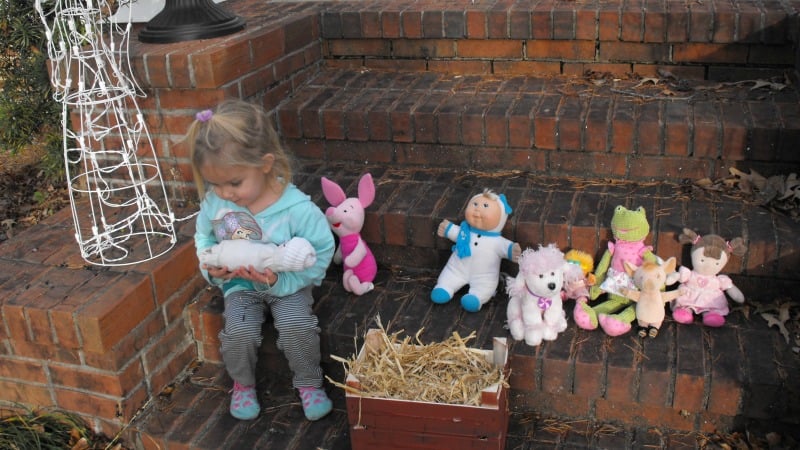Storytelling is a lost art. But despite how poorly I attempt to do it, my children and now my grandchildren love it. And did you know that most of the holiday signs and symbols that you now see all around you have a real Christmas meaning?
[Tweet "Most holiday signs + symbols have a real #Christmas meaning. By @CatholicFC"]
It would do all mothers and grandmothers good to have a cache of these beautiful legends in their arsenals, no matter how poorly they are told. Not only will you have restored some of the magic of storytelling, but you will also do a little more to help us all keep Jesus at the center of this busy season.
I will admit that I am the first to grab a screen and say let’s ask Siri, or let’s see if someone has made a YouTube about it when I stumble upon a hidden legend or mystery. Although I do that for most everything else, I have been purposely trying to keep some of the Christmas symbols alive with “live” stories. And I’ll admit, both spotting a story to tell and actually telling the story have gotten so much better. You of course can use Youtube and Wikipedia on your own to help with your story research.
Here is an example:
Look, Esther, did you know that this beautiful flower that we see at Christmas time is called a Poinsettia? It is actually a flower from Mexico. They call it the “Star of Christmas” because it flowers in the winter. We call it the Poinsettia because a man from our city (Greenville, SC) found the flower in Mexico while he was an Ambassador to that country. His name was Joel Poinsett. And in fact, we even have a Joel Poinsett that goes to our Catholic high school who was named after his great, great, great grandfather. Anyway, the people from Mexico have a special story that goes with this flower. A poor girl wanted to bring a special present to the Baby Jesus at their church's Christmas Eve Service, but she had nothing. She went to a nearby field where only grass was growing and picked what she thought were the best weeds and grasses that she could find. Oh, how she wanted to find some beautiful flowers, but she couldn’t find any. So she did the best she could with these weeds and made them into a bouquet. She remembered something that her brother had told her, “Even the smallest gift given in great love will make Jesus happy.” She presented her pitiful-looking gift at the altar. And guess what happened? That night, the weeds were replaced with a burst color and turned into what we call the Poinsettia. Everyone who saw the beautiful flowers thought it was a miracle. And indeed every beautiful flower is a miracle from God. They said that the shape of the flower is like the star of Bethlehem and the red color of the leaves symbolizes the blood of Christ which he was born to shed for us.
Of course, if I have time, I will draw it out a little further, both naming the girl and her brother. And many other details. . .
My hope is that every time my daughter (and now you!) sees a Poinsettia, she may be reminded of this story, and how Jesus wants our great love.
Here are some other stories revolving around Christmas that you’ll want to have ready at hand. Many of these stories do have beautiful books about them, too.
- The Legend of the Candy Cane. Basically it is about a candy maker who wants to make candy to remind us about Jesus. The colors symbolize the purity (white) and blood that will be shed (red). It looks like the letter “J” one way and a shepherd’s crook the other way. You could have a lot of fun in your story about this one—the candy maker could have a customer who was a selfish boy. . . even the candy maker could be evil and have a change of heart. . .
- The Christmas Tree. The tale I heard was that a man had a sick, bed-ridden daughter he was coming home to see. As he was passing through the fields in the night, he loved how the stars shown through the trees. He wanted to share this with his daughter who couldn’t get out. He cut down a tree, and when he got home he attached candles to the branches so that his daughter could see the same beauty. He made an extra beautiful star with a candle for the top to stand for the star of Bethlehem.
- The 12 Days of Christmas. Read this article from CatholicMom.com.
- Christmas Bells. At Christmas, the bells are rung during the Gloria at the Midnight Mass. This is such a “glorious” sound that now whenever we hear bells, we can’t help but think of those bells rang at Christmas Mass. And so bells became a symbol of Christmas. (They are rung at Easter, too, but I just can’t see Easter Bells? Glad we stayed with just Christmas.)
- Holly. The prickly leaves represent the crown of thorns and the berries represent drops of blood that were shed from the thorns.
- Presents. The Wisemen, of course.
- Nativity scenes. This custom was started by St. Francis of Assisi, who brought the first one to his church in 1223. This brought a resurgence of celebrating Christmas, which up to this time was hardly remembered.
Try some stories today!
Copyright 2016 Tami Kiser
About the Author

Tami Kiser
Tami Kiser is a wife, mother, teacher, author, and speaker. She runs a video production studio featuring Catholic speakers. These can be purchased or viewed on Formed. She also is the co-owner and host of a new Catholic Retreat and Cultural Center in the Carolina Mountains called Heart Ridge. She has taught everything from NFP, Zumba, cleaning toilets, Catholic crafting, the hula, bullet journaling, tap dancing, and liturgical living to Saxon Math 54 for the 10th time.



.png?width=1806&height=731&name=CatholicMom_hcfm_logo1_pos_871c_2728c%20(002).png)
Comments